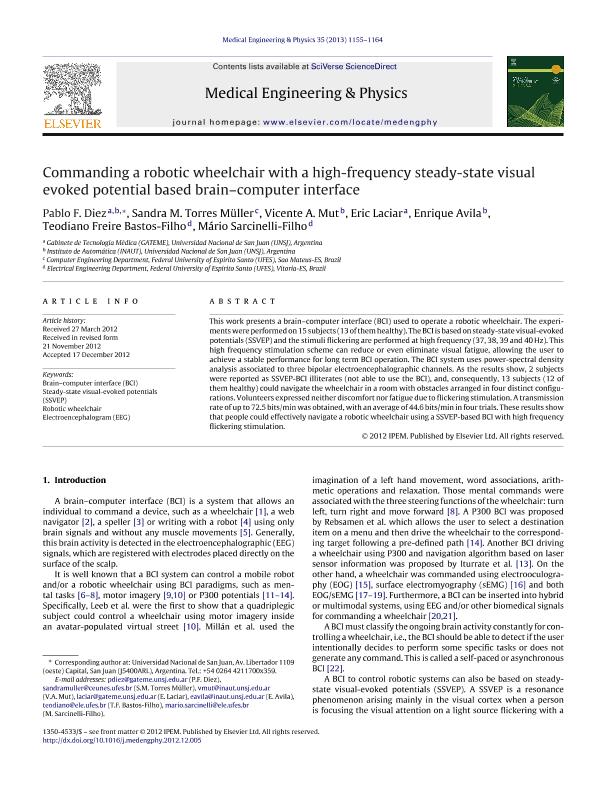Artículo
Commanding a robotic wheelchair with a high-frequency steady-state visual evoked potential based brain-computer interface
Diez, Pablo Federico ; Torres Müller, Sandra M.; Mut, Vicente Antonio
; Torres Müller, Sandra M.; Mut, Vicente Antonio ; Laciar Leber, Eric
; Laciar Leber, Eric ; Avila Perona, Enrique Mario; Freire Bastos Filho, Teodiano; Sarcinelli Filho, Mário
; Avila Perona, Enrique Mario; Freire Bastos Filho, Teodiano; Sarcinelli Filho, Mário
 ; Torres Müller, Sandra M.; Mut, Vicente Antonio
; Torres Müller, Sandra M.; Mut, Vicente Antonio ; Laciar Leber, Eric
; Laciar Leber, Eric ; Avila Perona, Enrique Mario; Freire Bastos Filho, Teodiano; Sarcinelli Filho, Mário
; Avila Perona, Enrique Mario; Freire Bastos Filho, Teodiano; Sarcinelli Filho, Mário
Fecha de publicación:
01/2013
Editorial:
Elsevier
Revista:
Medical Engineering & Physics
ISSN:
1350-4533
Idioma:
Inglés
Tipo de recurso:
Artículo publicado
Clasificación temática:
Resumen
This work presents a brain–computer interface (BCI) used to operate a robotic wheelchair. The experiments were performed on 15 subjects (13 of them healthy). The BCI is based on steady-state visual-evoked potentials (SSVEP) and the stimuli flickering are performed at high frequency (37, 38, 39 and 40 Hz). This high frequency stimulation scheme can reduce or even eliminate visual fatigue, allowing the user to achieve a stable performance for long term BCI operation. The BCI system uses power-spectral density analysis associated to three bipolar electroencephalographic channels. As the results show, 2 subjects were reported as SSVEP-BCI illiterates (not able to use the BCI), and, consequently, 13 subjects (12 of them healthy) could navigate the wheelchair in a room with obstacles arranged in four distinct configurations. Volunteers expressed neither discomfort nor fatigue due to flickering stimulation. A transmission rate of up to 72.5 bits/min was obtained, with an average of 44.6 bits/min in four trials. These results show that people could effectively navigate a robotic wheelchair using a SSVEP-based BCI with high frequency flickering stimulation.
Archivos asociados
Licencia
Identificadores
Colecciones
Articulos(INAUT)
Articulos de INSTITUTO DE AUTOMATICA
Articulos de INSTITUTO DE AUTOMATICA
Articulos(SEDE CENTRAL)
Articulos de SEDE CENTRAL
Articulos de SEDE CENTRAL
Citación
Diez, Pablo Federico; Torres Müller, Sandra M.; Mut, Vicente Antonio; Laciar Leber, Eric; Avila Perona, Enrique Mario; et al.; Commanding a robotic wheelchair with a high-frequency steady-state visual evoked potential based brain-computer interface; Elsevier; Medical Engineering & Physics; 35; 8; 1-2013; 1155-1164
Compartir
Altmétricas



